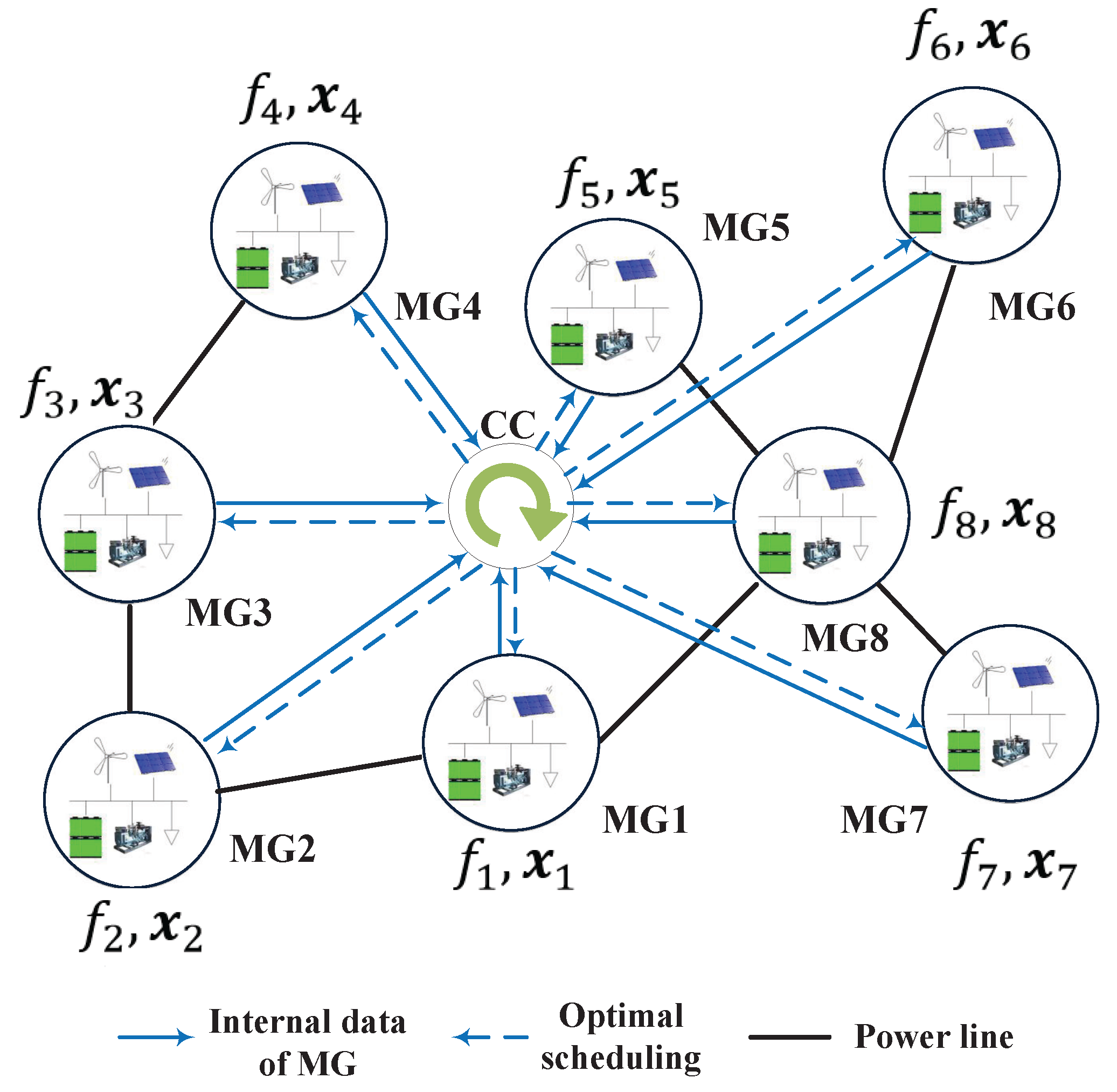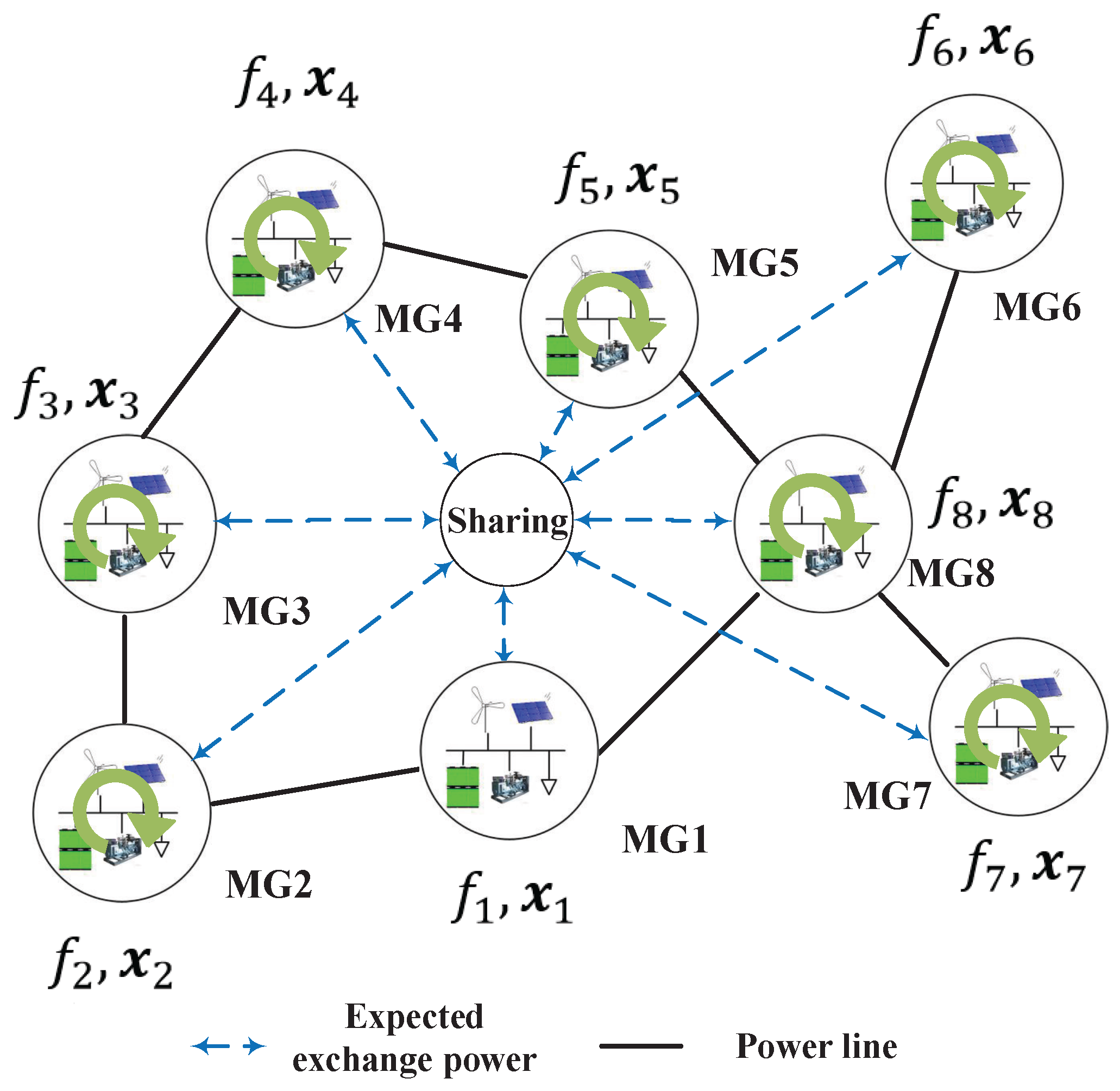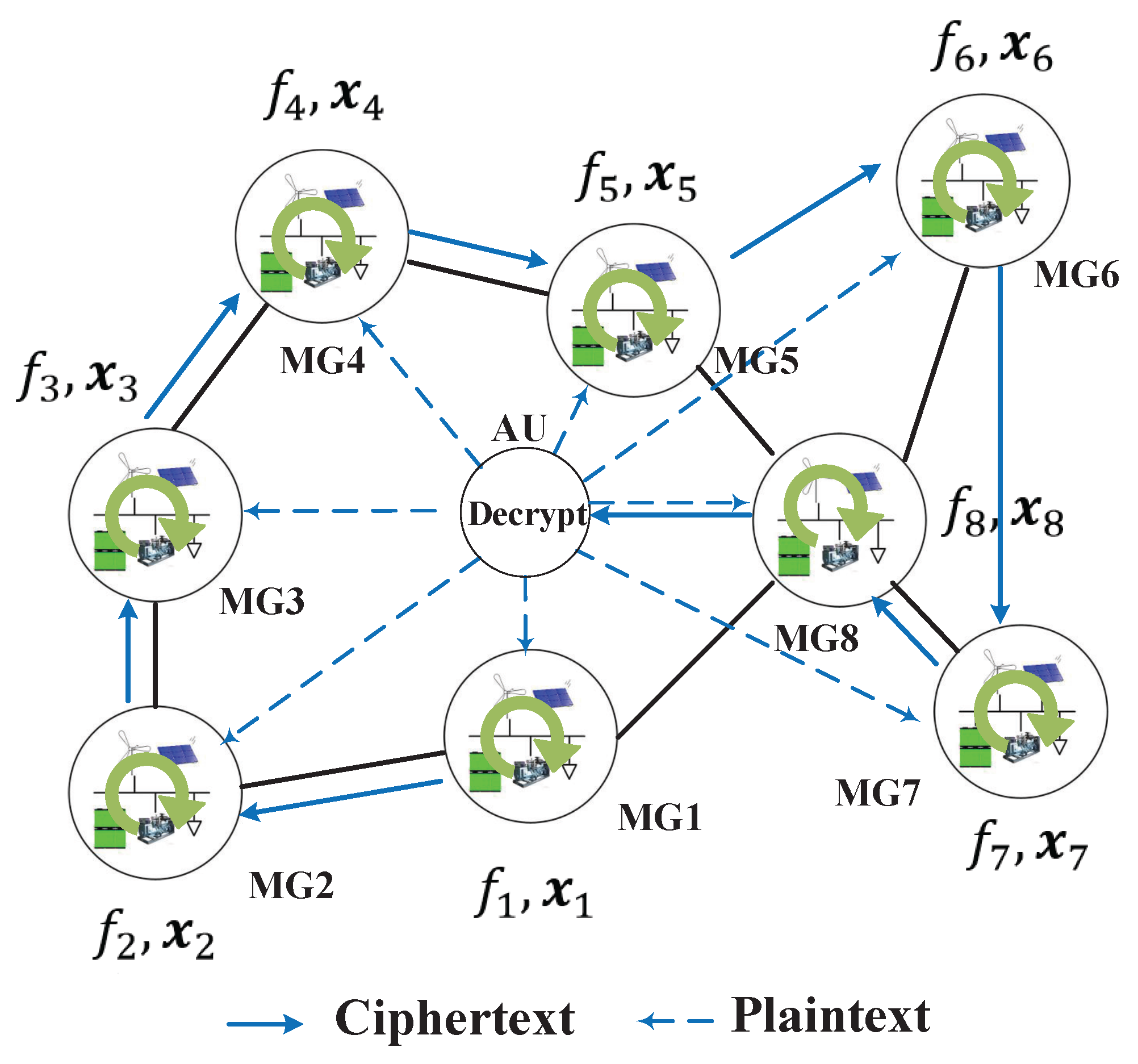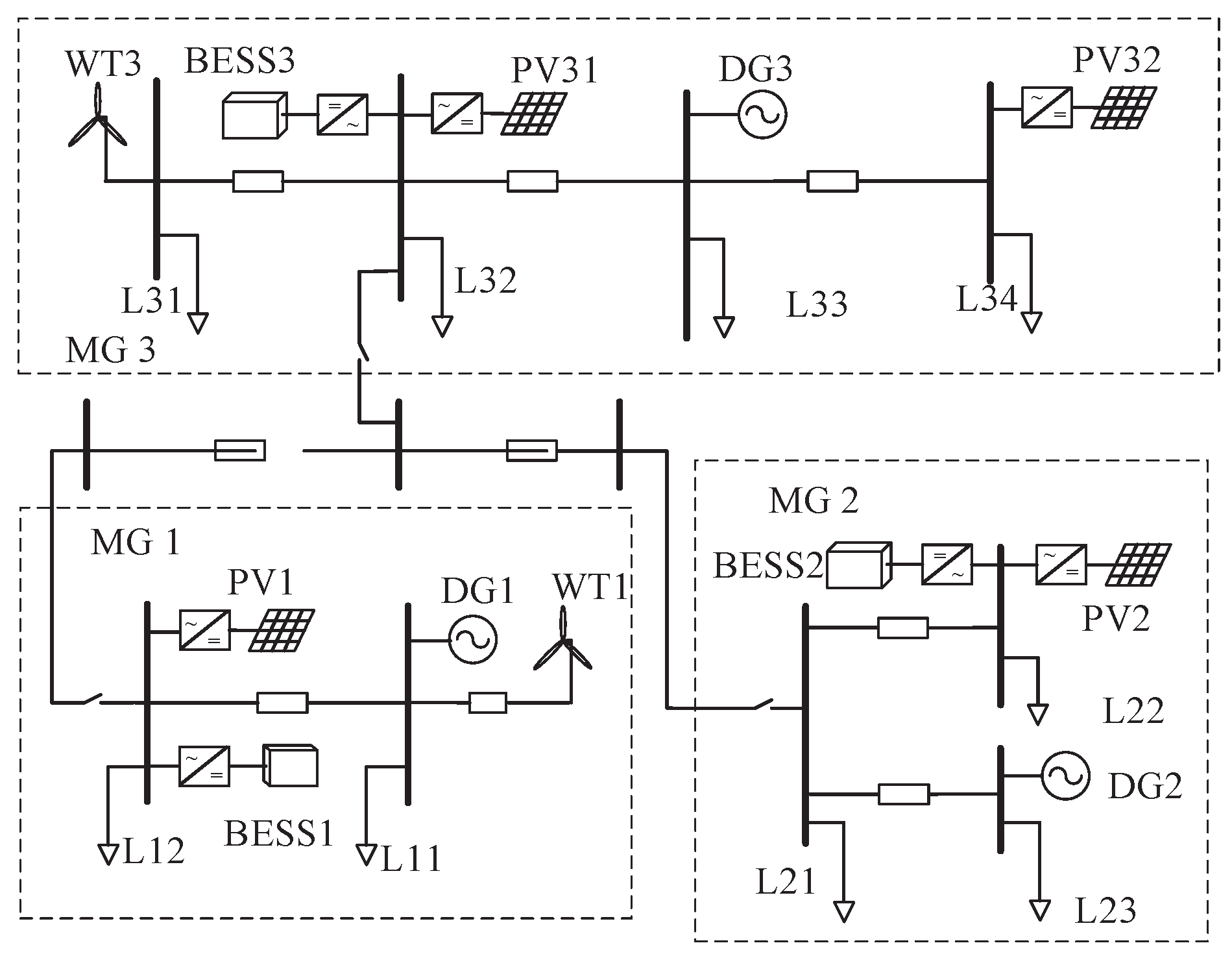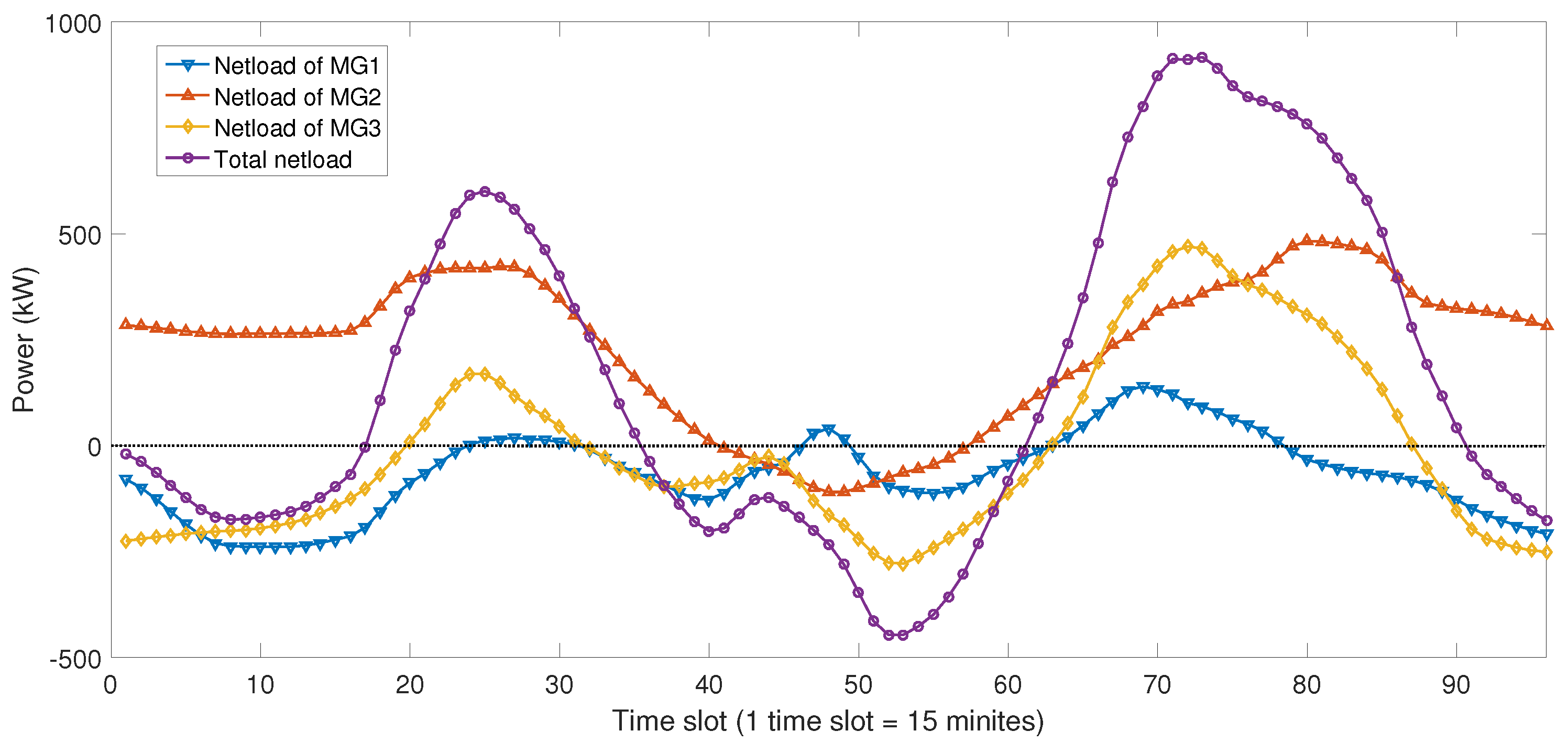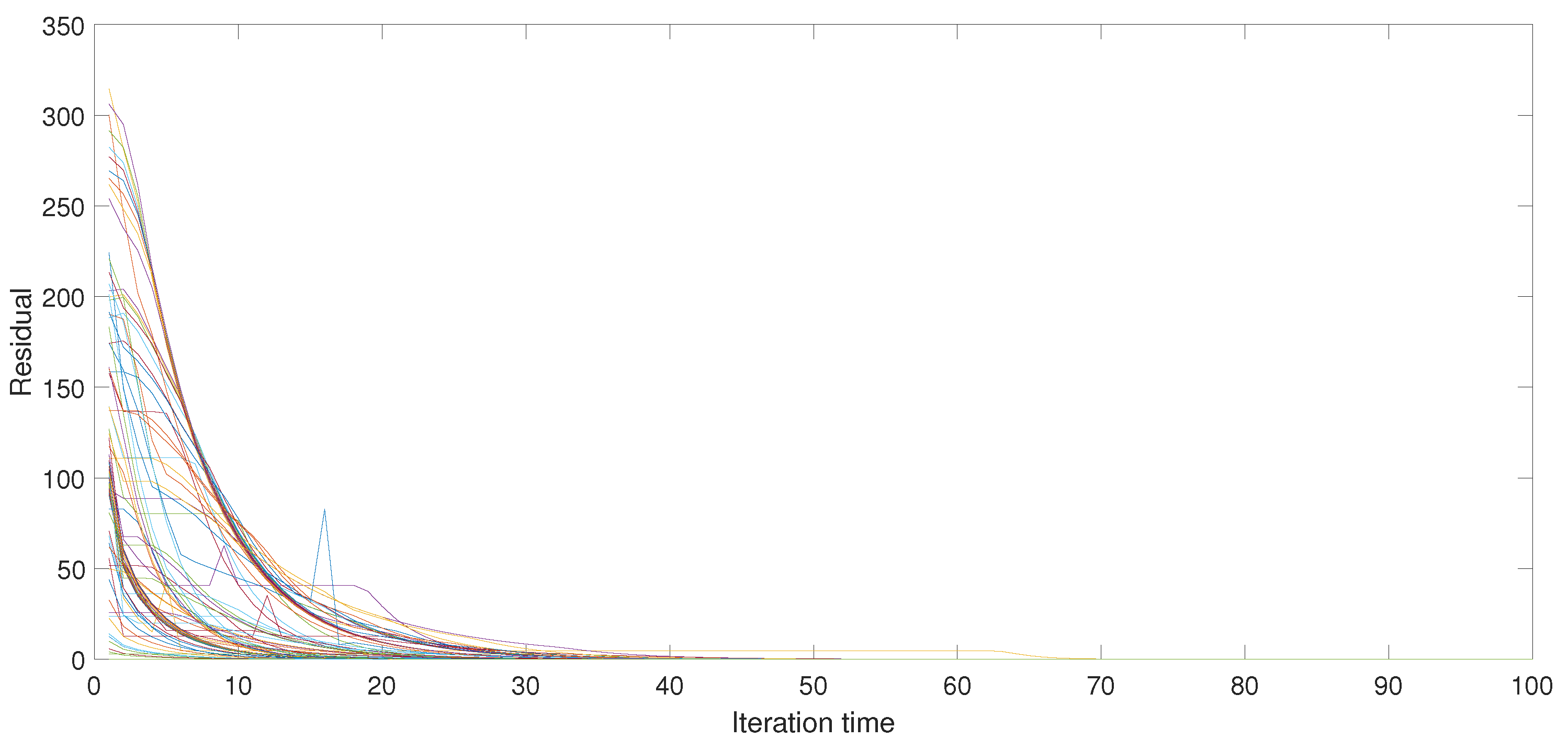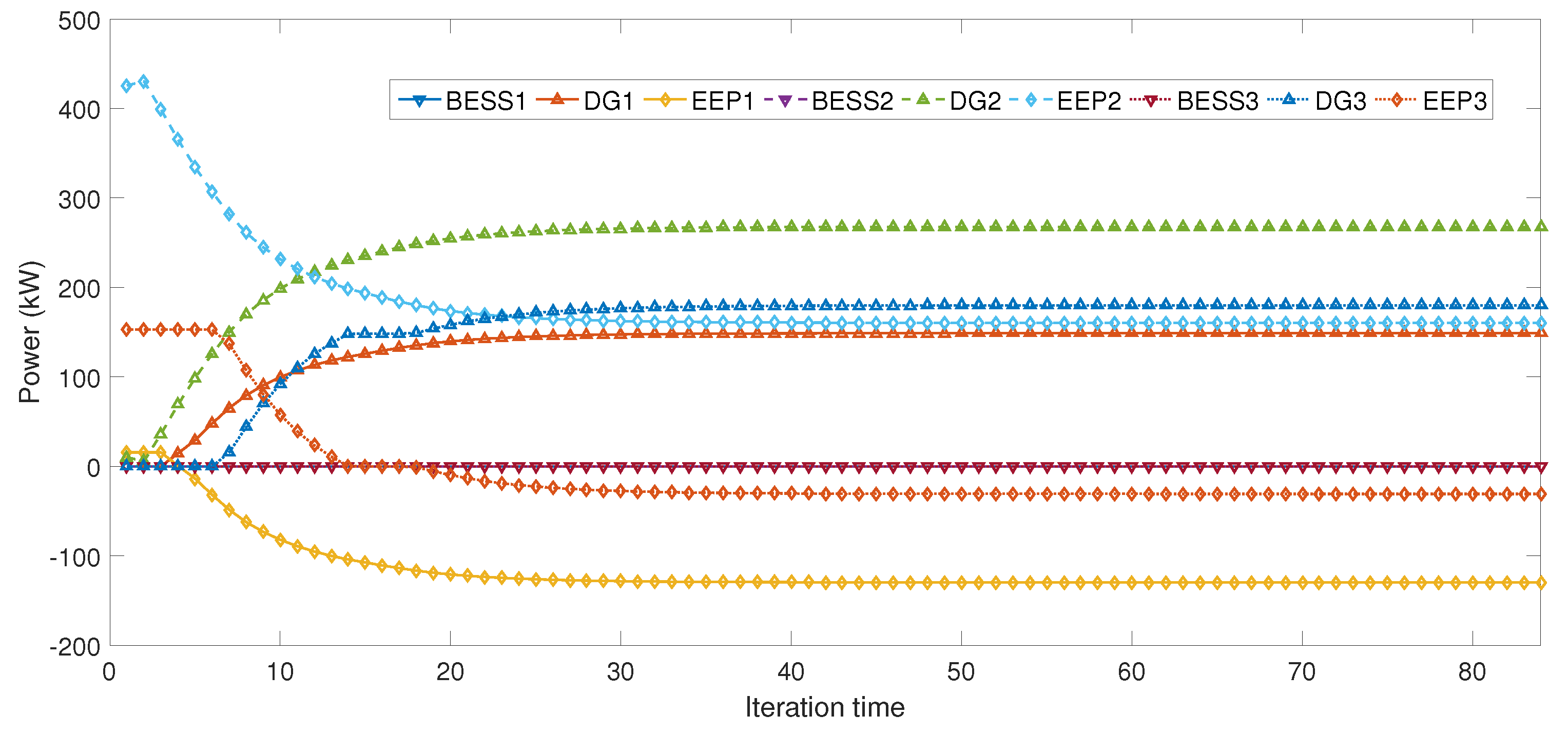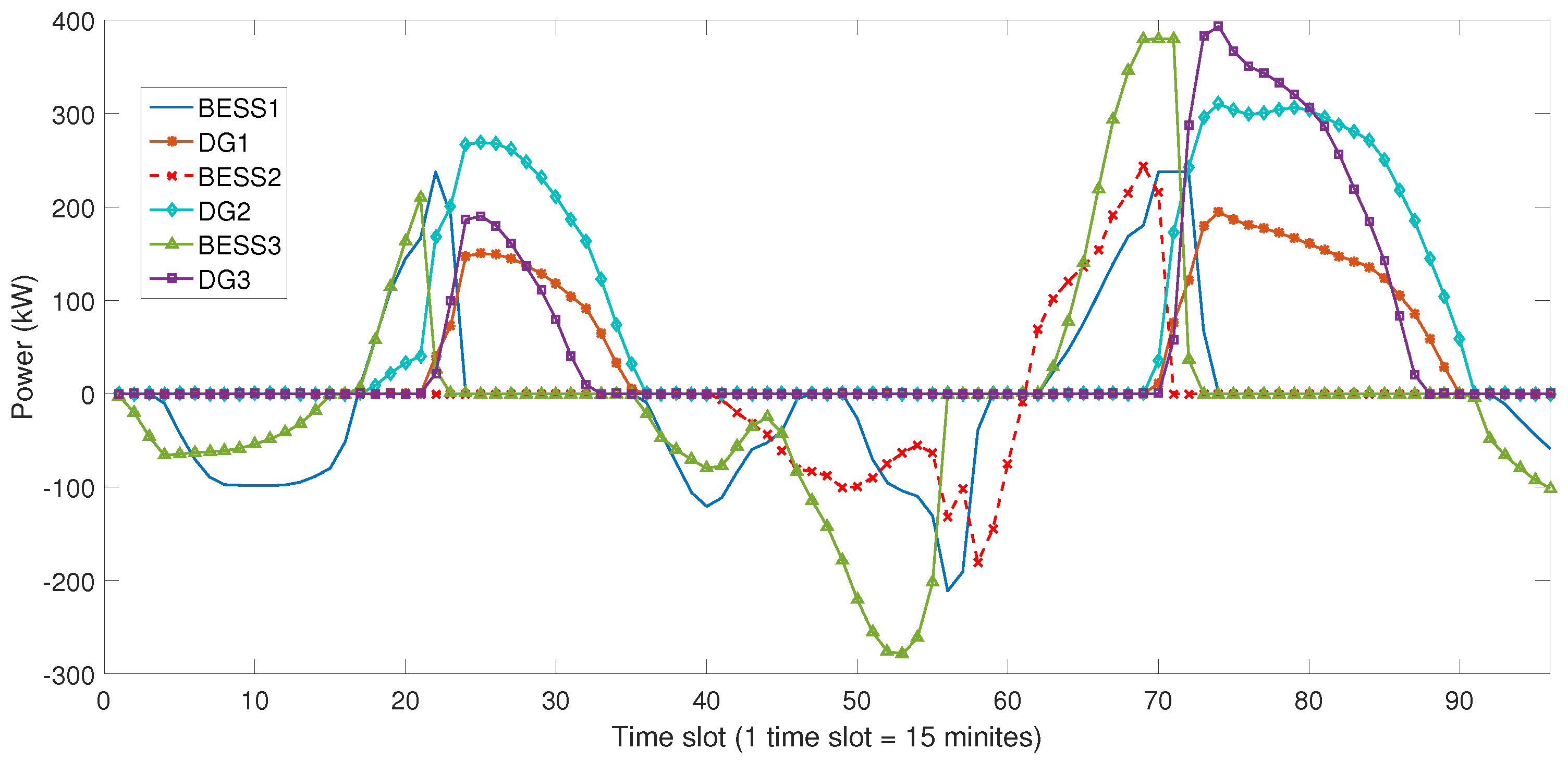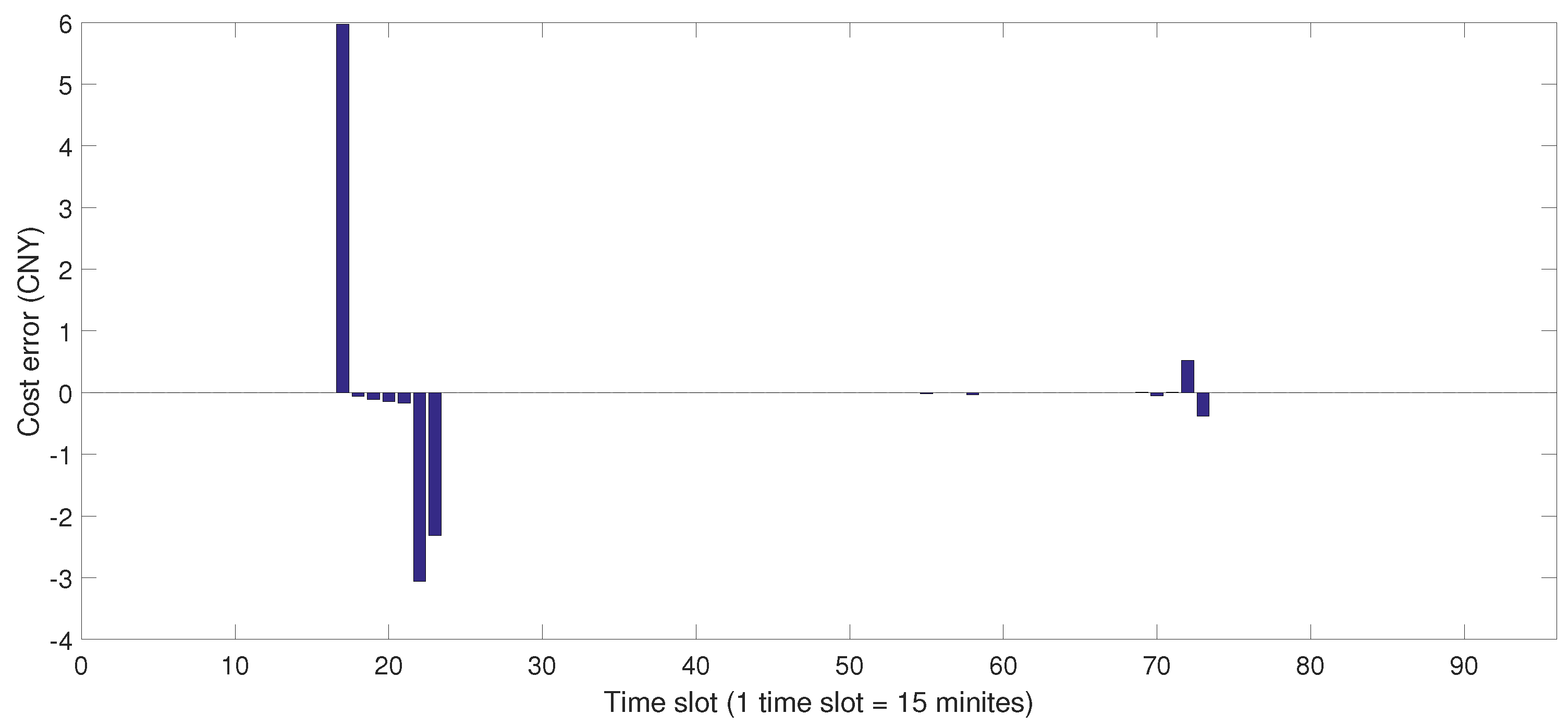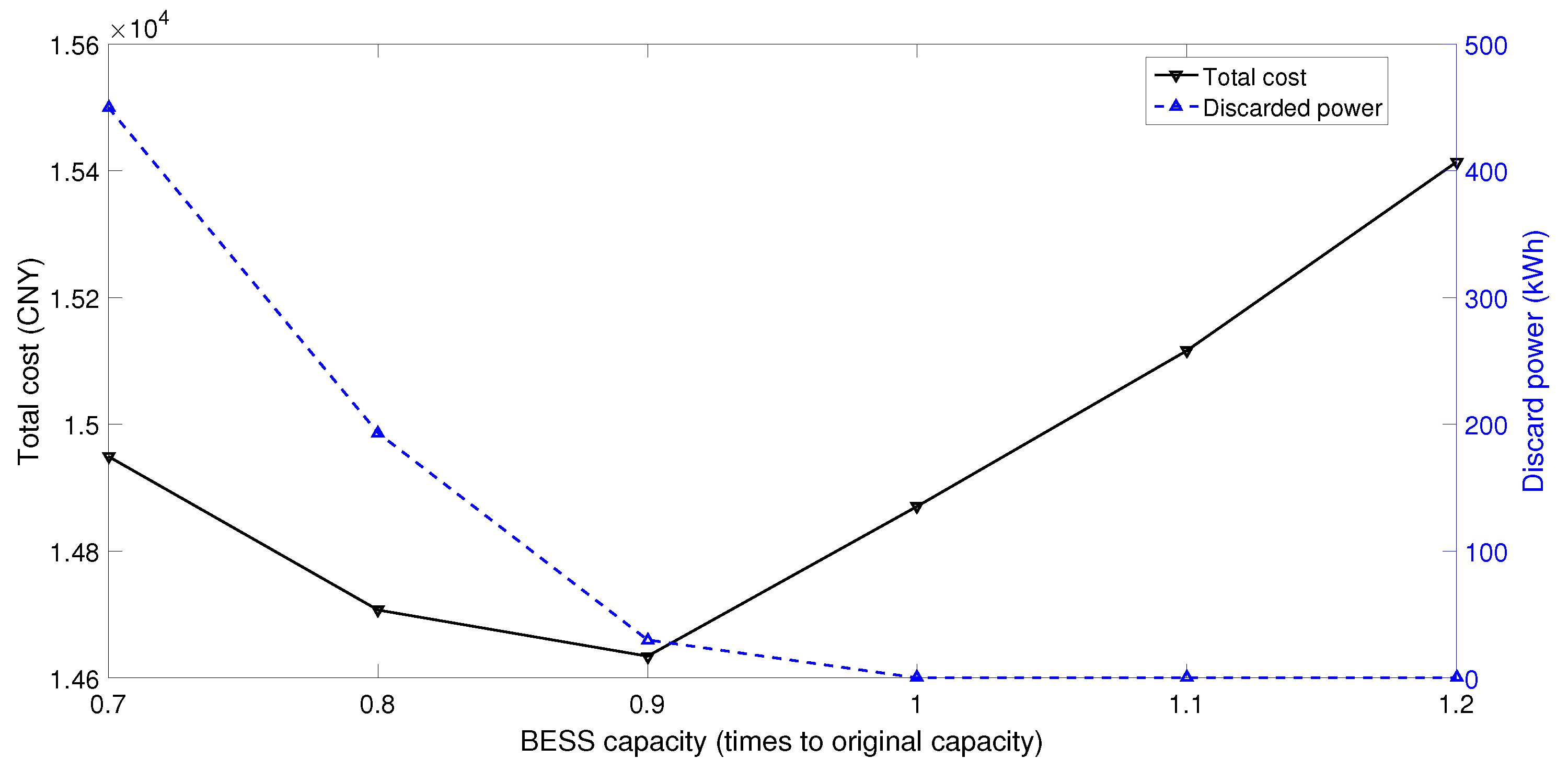1. Introduction
Microgrids (MGs) are self-controlled entities, which facilitate the penetration of renewable energy and distributed energy resources (DERs) for economic and reliability purposes. Generally, the MG can be operated in either grid-connected [
1] or island mode [
2]. With the development of MGs, a new typical approach is to consider where several MGs exchange energy with one another even when the MGs are isolated from the utility grid. In other words, there exist energy flows within a group of physically-connected MGs, but not between the MGs and the main grid. One promising application of interconnected MGs (IMG) is for the service restoration in a self-healing distribution system to improve the dynamic performance when islanding occurs and to extend the power supply during the system outages [
3,
4]. Another important application is to ensure the full utilization of renewable energy resources (RESs) and improve the economic benefit and reliability in isolated areas [
5]. Consequently, the interconnected operation of multi-MGs is becoming a promising strategy for the smart grid.
Considering the type of MGs, the interconnection among autonomous MGs can be realized via an AC [
6,
7], DC [
8] or AC-DC hybrid architecture [
9]. As a newly-emerging topic of the smart grid, there are still limited research works focused on the related problems of IMGs. The studies can be roughly divided into two categories: (1) coordinated control and (2) energy management. For the coordinated control, the feasibility (benefits) and basic controls of IMGs via AC connections were studied in [
6,
7]. Moreover, in [
5,
9,
10], considering that the AC MGs may be operated at different voltages and frequencies, hybrid AC/DC links and coordinated control schemes were studied for maintaining the autonomy of each MG during interconnections. For the interconnection of DC MGs, several control methods were proposed, such as the control strategy for two DC MGs [
11], distributed hierarchical control [
12] and distributed two-level tertiary control [
13] for a cluster of DC MGs.
Energy management is another category of study for the IMG. To ensure the full utilization of RES and to minimize the operation cost, effective scheduling of the DERs and battery energy storage systems (BESS) [
14] is highly necessary. Generally, if all of the MGs could share the information on their respective load data, generation data and parameters and grid parameters, the optimal scheduling could be easily realized based on the traditional centralized optimization [
15], such as optimal power flow (OPF). However, for security considerations, it is not desirable for each MG to do so because the shared information could compromise the privacy of each MG. Thus, this is the basic driving force of the distributed optimization of IMG scheduling. For instance, a distributed convex optimization framework was developed for energy trading between islanded MGs [
16]. The problem consists of several islanded MGs that exchange energy flows by means of an arbitrary topology. In [
17], the authors studied the self-organization and decentralized energy management of an MG cluster islanded from the main grid after a disruptive event.
However, even with applying distributed optimization, there are still weak points in these works. First, for privacy preserving, the algorithms require the MGs to share enough data with others during the optimization. For instance, the trading prices and corresponding trading energy should be shared between the neighboring MGs in [
16], and the expected power exchange of each MG should be shared with all other MGs in [
17]. After long-term operation, the generation details and energy consumption patterns of one MG can be gradually inferred by other MGs using data mining [
18], which could gradually affect the confidentiality and privacy [
19]. In the smart grid, data perturbation and aggregation are the two main privacy-preserving approaches that have been applied to avoid the inference of sensitive information from the metering data [
20]. For privacy preserving, the assumed attacks are mainly based on non-intrusive monitoring of energy usage traces. Typical solutions rely on battery-based load hiding [
21,
22], on noise injection [
23] or on a multi-party computation cryptosystem [
24,
25]. However, in the distributed optimization framework, the shared data are tightly coupled with the local optimization and circulated during the execution of the scheduling horizon. In this regard, the solutions of battery-based hiding and noise injection are difficult to apply. Second, the modeling of BESS is not considered in the optimization of IMG. For the MGs consisting of wind, solar and diesel generations, the BESS is an important component to increase the utilization of RES [
26,
27]. With suitable sizing [
26,
28] and coordinated control [
29], BESS could have great influence on the optimal scheduling of MGs.
To this end, this paper proposes a privacy-preserving distributed optimal scheduling method for energy management of IMG, with the consideration of BESS and RES. The main contributions of the paper are as follows: (1) based on the relationship between charging-discharging features and the battery life cost, the cost model of BESS is formulated as a quadratic polynomial; (2) by using the framework of the alternating direction method of multipliers (ADMM), a distributed optimal scheduling model and iterative algorithm is proposed; (3) based on the multi-party computation cryptosystem, a privacy-preserving strategy to protect the sharing of expected exchanging power (EEP) between MGs is designed to work with the iterative algorithm.
4. Privacy-Preserving Strategy
As shown in (
27) and Algorithm 1, each MG should share its own EEP. After that, the average EEP will be calculated and sent back to all of the participating MGs. Considering the privacy, each MG should share its own EEP, but does not want to show it to the other MGs. By coincidence, as the Paillier cryptosystem has the features of homomorphic addition, indistinguishability and self-blinding, it is feasible to transfer the addition of plaintext EEPs to the multiplication of ciphertext EEPs, which makes it quite suitable for privacy preserving in the sharing of EEPs [
38].
4.1. Basic Theory of the Paillier Cryptosystem
The Paillier cryptosystem is widely used in a distributed environment and can protect users’ privacy in the collaboration process [
39]. The basic schema of Paillier includes three parts, which are described as follows [
38].
4.1.1. Key Generation
Select two prime numbers
p and
q, and calculate
and
:
where
means the operation of calculating the lowest common multiple. We denote Euler’s totient function
taken on
, i.e.,
in the present case. Recall that
, then a random number
is needed and should satisfy:
where
and
is the operation of calculating the greatest common divisor. The Paillier public key and private key are
and
.
4.1.2. Encryption
Assume that
is plaintext,
is a random number and
is the encryption operation.
4.1.3. Decryption
Assume that
is ciphertext and
is the decryption operation with the private key
.
To secure the Paillier cryptosystem’s privacy, parameter
and
should be big enough.
, the formula holds:
which indicates that the result of the multiple operation of two ciphertexts is equal to the encryption result of the sum of two plaintexts, and this is Paillier’s homomorphic addition characterization.
As can be seen, the plaintext should be an integer in the process of encryption, but the information exchanged might be decimals in actual applications. To make this cryptosystem useful, a constant multiple is used to amplify the plaintext.
4.2. Protocol of EEP Sharing
Firstly, an authority entity for the IMG is required, which is denoted as . The public key and private key of the are denoted as and . The public key is known to every MG participating in the IMG, and the private key is only known by the itself.
Secondly, the sharing for the EEP of every MG is implemented in a series manner. The route of information delivery must be fixed and known to every MG for each iteration.
As we know,
is the private data of MG
n, and its ciphertext encrypted by the public key of
can be denoted as
, which is transmitted from MG
n to
. After each step,
is the last receiver of the ciphertext and uses its private key to decrypt and broadcast the data to all of the MGs. The detailed information exchange procedure is listed as follows (see
Figure 3).
Step 1: Every MG optimizes its own EEP , encrypts the plaintext by using ’s public key and gets the ciphertext .
Step 2: MG 1 transmits
to MG 2, and then MG 2 should calculate as:
After calculation,
is transferred to the next MG and does the same operation until the last MG.
Step 3: The last MG
N sends the cipher data to
, and
has the private key to perform the decryption process. Finally, the average EEP for distributed optimization is broadcast to all MGs.
4.3. Security Analysis of the Protocol
We use the semi-honest security model to analyze the protocol [
40]. This model assumes that the involved parties, in our case MG 1 to MG
N and the
, perform the protocol steps properly, but are also allowed to store the messages from previous steps in an attempt to deduce more information than they are entitled to. Based on the semi-honest model, we can enumerate three different attach scenarios: (1) all of the MGs are trustful, but the AU is untrustful; (2) some of the MGs are untrustful and collusive, but the AU is trustful; (3) some of the MGs are untrustful and collusive, and the AU is also untrustful.
For the first scenario, the sensitive data of each MG are encrypted and delivered on a fixed path. The AU can receive the ciphertext of summing EEP . Although the plaintext can be decrypted as , the actual data of arbitrary MGs cannot be deduced.
For the second scenario, as the EEP of each MG is encrypted by the public key of AU , even if there are a number of collusive MGs, the plaintext of any MGs cannot be obtained without the private key of AU.
For the third scenario, we assume that there are collusive MGs. (a) When , that is only one non-collusive MG exists (denoted as MG-a), then, the MG-a is the target of the collusive MGs. In this case, if all of the collusive MGs can share their own plaintexts with the AU or set their EEPs to zero, the AU can get the privacy data of MG-a. Otherwise, the privacy of MG-a still can be guaranteed. However, this condition is difficult to achieve, since it would also affect the privacy of the collusive MGs or make it easy to be detected by MG-a. (b) When , that is the number of non-collusive MGs is not less than two. Similar to the condition of , the untrustful AU can only get the sum of EEPs from the non-collusive MGs (e.g. ) even with the worst conditions.
Therefore, the privacy-preserving protocol can guarantee the privacy of every MG under the check of the semi-honest model.
6. Conclusions
A privacy-preserving distributed scheduling method for IMG with battery storage and renewable energy resources is proposed. According to the case study and experiment results, the method has almost the same optimization result with the centralized optimization, and the privacy of each MG can also be guaranteed. The processes of the iteration algorithm and privacy-preserving have delayed the implementation time of optimal scheduling, but still can be accepted for the condition with the minimum time slot longer than 10 min, which is suitable for the optimal scheduling problem of IMG.
The proposed method can be extended in several ways. Firstly, one interesting problem is the involvement of flexible loads (i.e., shiftable appliances, controllable heating, ventilation and air conditioning loads, etc.). In this scenario, the MG operator can choose to adjust the load, the generation of DGs or trade with other MGs, with the comprehensive consideration of the generation cost, trading price, load characteristic and demand response cost. Secondly, another interesting problem is the time horizon of optimization. In energy management that includes multiple time periods, the intertemporal constraint for remaining energy of BESS should be further considered. This constraint may have an influence on the distributed model, which needs further study. Finally, as the participating MGs are assumed to work as a coalition, the basic principle for forming a coalition and the related re-distribution strategy of cooperative benefits by using the IMG still need further research.
